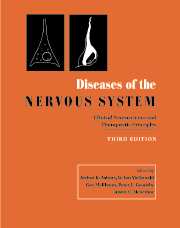Book contents
- Frontmatter
- Dedication
- Contents
- List of contributors
- Editor's preface
- PART I INTRODUCTION AND GENERAL PRINCIPLES
- PART II DISORDERS OF HIGHER FUNCTION
- PART III DISORDERS OF MOTOR CONTROL
- PART IV DISORDERS OF THE SPECIAL SENSES
- PART V DISORDERS OF SPINE AND SPINAL CORD
- PART VI DISORDERS OF BODY FUNCTION
- PART VII HEADACHE AND PAIN
- 58 Peripheral nociception and the genesis of persistent clinical pain
- 59 Central nervous system mechanisms of pain
- 60 Management of chronic pain
- 61 Migraine
- 62 Cluster headache, other trigeminal autonomic syndromes and the short-lived headaches
- 63 Orofacial pain
- 64 Chronic daily headache
- Complete two-volume index
- PART VIII NEUROMUSCULAR DISORDERS
- PART IX EPILEPSY
- PART X CEREBROVASCULAR DISORDERS
- PART XI NEOPLASTIC DISORDERS
- PART XII AUTOIMMUNE DISORDERS
- PART XIII DISORDERS OF MYELIN
- PART XIV INFECTIONS
- PART XV TRAUMA AND TOXIC DISORDERS
- PART XVI DEGENERATIVE DISORDERS
- PART XVII NEUROLOGICAL MANIFESTATIONS OF SYSTEMIC CONDITIONS
- Complete two-volume index
- Plate Section
60 - Management of chronic pain
from PART VII - HEADACHE AND PAIN
Published online by Cambridge University Press: 05 August 2016
- Frontmatter
- Dedication
- Contents
- List of contributors
- Editor's preface
- PART I INTRODUCTION AND GENERAL PRINCIPLES
- PART II DISORDERS OF HIGHER FUNCTION
- PART III DISORDERS OF MOTOR CONTROL
- PART IV DISORDERS OF THE SPECIAL SENSES
- PART V DISORDERS OF SPINE AND SPINAL CORD
- PART VI DISORDERS OF BODY FUNCTION
- PART VII HEADACHE AND PAIN
- 58 Peripheral nociception and the genesis of persistent clinical pain
- 59 Central nervous system mechanisms of pain
- 60 Management of chronic pain
- 61 Migraine
- 62 Cluster headache, other trigeminal autonomic syndromes and the short-lived headaches
- 63 Orofacial pain
- 64 Chronic daily headache
- Complete two-volume index
- PART VIII NEUROMUSCULAR DISORDERS
- PART IX EPILEPSY
- PART X CEREBROVASCULAR DISORDERS
- PART XI NEOPLASTIC DISORDERS
- PART XII AUTOIMMUNE DISORDERS
- PART XIII DISORDERS OF MYELIN
- PART XIV INFECTIONS
- PART XV TRAUMA AND TOXIC DISORDERS
- PART XVI DEGENERATIVE DISORDERS
- PART XVII NEUROLOGICAL MANIFESTATIONS OF SYSTEMIC CONDITIONS
- Complete two-volume index
- Plate Section
Summary
Pain is the most common reason that patients seek medical attention. Most community-based surveys indicate that at least 15% of the population have chronic pain associated with adverse consequences in varied domains of functioning (Smith et al., 2001). The aggregate cost of unrelieved pain for health care systems and national economies is staggering.
All clinicians encounter patients with chronic pain. An understanding of the nature of pain provides a foundation for comprehensive assessment. Assessment, in turn, guides the long-term therapeutic strategy for enhancing the comfort of these patients and addressing their painrelated disability.
Definition of pain
Pain has been defined by the International Association for the Study of Pain (IASP) as ‘an unpleasant sensory and emotional experience which we primarily associate with tissue damage or describe in terms of such damage, or both (Mersky & Bogduk, 1994)’. This definition underscores the potential contribution of sensory, emotional, and cognitive processes in the experience of pain, and the complex relationship between tissue injury and pain perception. Although pain is typically perceived to be a primary indicator of tissue injury, the relationship between pain and tissue damage is neither uniform nor constant. Pain may occur in association with progressive or stable chronic disease, or may occur in the complete absence of an identifiable lesion.
This complexity highlights the need to distinguish the neural processes initiated by tissue injury from pain. The mechanisms induced in neural pathways by potentially tissue-damaging stimuli are termed ‘nociception’, and are neither necessary nor sufficient for the experience of pain. Pain is the perception of nociception, and like other perceptions, is inherently subjective and can be influenced by a variety of non-nociceptive factors. These factors may be organic, e.g. the aberrant processes in the nervous system that result in neuropathic pain, or psychologic.
Given the subjective nature of pain, pain specialists generally believe that the clinician is best served by assuming that the patient is reporting a true experience, even when a causative lesion cannot be demonstrated. Clinical discussion focused on whether or not a pain is ‘real’ usually obscures the important issues and is unhelpful.and, in almost all cases, the clinician is better served by assuming that the pain is truly experienced and then thoughtfully inferring the range of factors – ongoing tissue injury, neuropathic processes and psychologic processes – that may be sustaining the pain.
- Type
- Chapter
- Information
- Diseases of the Nervous SystemClinical Neuroscience and Therapeutic Principles, pp. 906 - 919Publisher: Cambridge University PressPrint publication year: 2002
- 1
- Cited by

